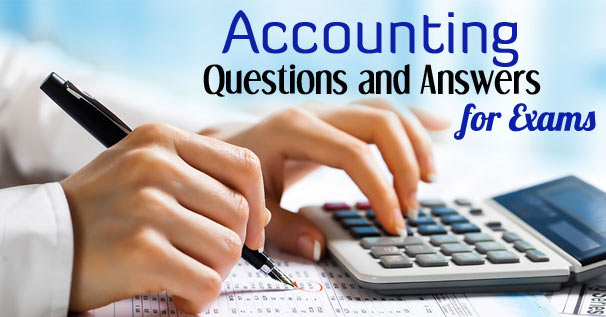
If you are preparing for Bank exams / Banking interview and want to get strong catching on accounting, then don’t forget to study of these questions on accounting given below. Here a collection of questions on basic accounting with answers asked in the previous exams is given. Study of these questions will helpful to learn the exams pattern and to get sure success.
1. Accounting provides information on–
(A) Cost and income for managers (B) Company’s tax liability for a particular year
(C) Financial conditions of an institution (D) All of the above (Ans: D)
2. Accounting Policies and Procedures onces decided should not be changed till any sound reason is there. This is know as–
(A) Accrual Concept (B) Conservatism
(C) Business Entity Concept (D) Consistency (Ans: D)
3. According to accounting equation assets are equal to?
(A) liabilities (B) liabilities and equities
(C) equities (D) none of these (Ans: B)
4. The accounting cycle represents a series of steps that a business uses–
(A) to record and classify the transactions (B) to summarize the transactions
(C) to communicate financial events (D) for all of these (Ans: D)
5. Current liabilities need to be paid–
(A) within one accounting cycle (B) beyond one accounting cycle
(C) within 3 years (D) within 6 months (Ans: A)
6. Financial accounting looks for the interests of–
(A) Investors (B) Employees
(C) Suppliers (D) Both investers and suppliers (Ans: D)
7. Financial Accounting considers the transactions–
(A) in terms of money (B) important from business point of view
(C) not in terms of money (D) All of the above (Ans: D)
8. Recording of expenditures of the organization in a systematic manner–
(A) Financial Accounting (B) Balance Sheet
(C) Cost Accounting (D) Book Keeping (Ans: C)
9. In financial accounting records the entities whose monitary value is not known are not entered. This concept is–
(A) Double Entry Book Keeping Method (B) Cost Concept
(C) Objectivity (D) Money Measurment Concept (Ans: D)
10. The Financial record should always be published in a definite time period according to–
(A) Accounting Period Concept (B) Cost Concept
(C) Money Measurment Concept (D) Consistency (Ans: A)
11. Accounting System used for the organizations not earning any profit is–
(A) Accrual System (B) Cash System
(C) Mercantile System (D) Non-profitary System (Ans: B)
12. When does an accountant record a transaction?
(A) If it is materialized by a concrete document (B) if it has a tax implication
(C) on Manager’s demand (D) None of these (Ans: A)
13. The accounts that records expenses, gains and losses are–
(A) Personal accounts (B) Real accounts
(C) Nominal accounts (D) None of the above (Ans: C)
14. Real accounts records–
(A) Dealings with creditors or debtors (B) Dealings in commodities
(C) Gains and losses (D) All of the above (Ans: B)
15. Systematic recording of business transactions in books of account is–
(A) Auditing (B) Book Keeping
(C) Financial Accounting (D) Balance Sheet (Ans: C)
16. Which is a Personal Account ?
(A) Account of customer (B) Salary Account
(C) Telephone Expenses Account (D) Trade Market Account (Ans: A)
17. Which is a Nominal Account ?
(A) Goodwill Account (B) Machinery Account
(C) Account of the supplier (D) None of the above (Ans: D)
18. Which is a Real Account ?
(A) Land Account (B) Building Account
(C) All of the above (D) None of the above (Ans: C)
19. Companies profit divided among shareholder is–
(A) interest (B) reserve
(C) dividend (D) surplus (Ans: C)
20. Double entry book-keeping was started by–
(A) F. W Taylor (B) Henry Fayol
(C) Lucas Pacioli (D) Adam Smith (Ans: C)
21. Which of the following equations represents the balance sheet?
(A) Assets + Liabilities = Shareholders’ equity
(B) Assets = Liabilities = shareholders’ equity
(C) Assets = Liabilities – Shareholders’ equity
(D) Assets = Liabilities + Shareholders’ equity (Ans: D)
22. Patents, Copyrights and Trademarks are–
(A) Current assets (B) Fixed assets
(C) Intangible assets (D) Investments (Ans: C)
23. Balance sheet is a statement of–
(A) Assets (B) Liability
(C) Capital (D) All of the above (Ans: D)
24. Current ratio =
(A) Quick assets / Current liabilities (B) Current assets / Current liabilities
(C) Debt. / Equity (D) Current assets / Equity (Ans: B)
25. Return on Investment Ratio (ROI) =
(A) (Gross profit / Net sales) x 100 (B) (Gross profit x Sales / Fixed assets) x 100
(C) (Net profit / Sales) x 100 (D) (Net profit / Total assets) x 100 (Ans: D)
26. Financial Statement of business at any targeted time in terms of assets and liabilities–
(A) Book Keeping (B) Profitability Statement
(C) Balance Sheet (D) Audit (Ans: C)
27. Businessman always see business running for an indefinite period. This concept is–
(A) Accounting Period Concept (B) Money Measurment Concept
(C) Consistency (D) Going Concern Concept (Ans: D)
28. Which type of expenditure is shown in asset side of Balance sheets?
(A) Capital Expenditure (B) Reffered Revenue Expenditure
(C) Revenue Expenditure (D) None of the above (Ans: B)
29. Which method of capital budgeting called benefit cost ratio?
(A) Pay back period method (B) Net present value method
(C) Payout period method (D) Profitability Index method (Ans: D)
30. Which is the Principle of Capital Structure?
(A) Cost and control principle (B) Risk principle
(C) Both (A) and (B) (D) None of the above (Ans: C)
Comments
Post a Comment